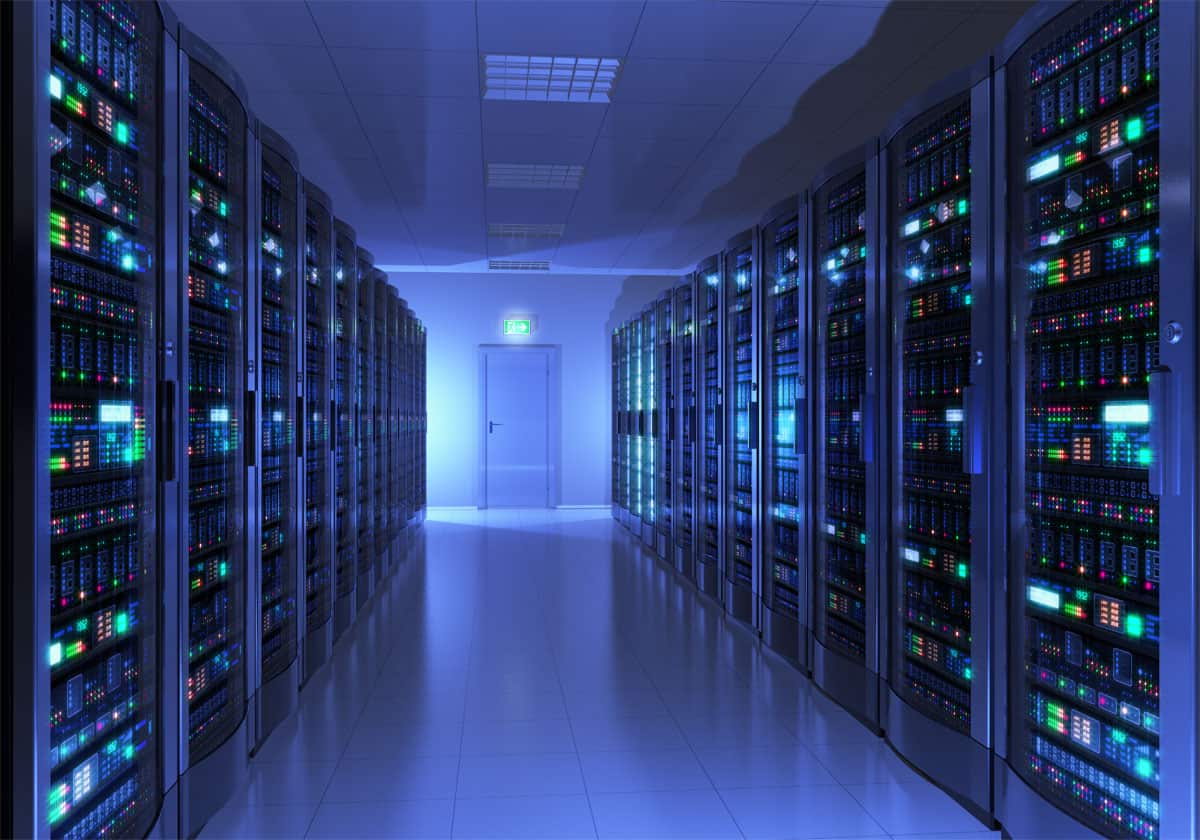As a business owner, you must outsource equipment and services from other companies. One of the best practices in enterprise business is using a colocation center.
Colo data center definition. What is a colo facility?
A colocation center, colo, or carrier hotel is a rented data center located in a secure physical site or building. Enterprise companies rent data center colocation services and get infrastructure (building), cooling, power, bandwidth, physical security, etc., at a reasonable cost. Enterprise companies usually own only storage and servers.
Colocation solutions or Types of Colocation Facilities are Retail Colocation (space within a data center within a rack), Wholesale Colocation (lower power and space requirements than retail colo), and Hybrid Cloud-Based Colocation (mix of in-house and outsourced data center services). Standard colocation features are Facilities, power, physical security, and cooling.
This minimizes overhead and optimizes communications efficiency for all participants because the infrastructure is sufficient to handle all the information sometimes required during peak demand. A colocation center may be a sizable facility, often containing 5,000 square meters (approximately 54,000 square feet) of floor space.
Internet colocation
Businesses that enjoy colocation cecenter’ilization include internet site hosting companies, storage service colo providers, and telecommunications companies.
Colocation refers to the space supply for communications equipment on the service colo premises. For instance, an internet site owner can place the servers on an online service provider (ISP). A colocation center provides colocation on a vast scale, offering various services to customers, from modest racks to dedicated rooms or groups of rooms. A colocation center can also house a gathering room where human representatives for all the businesses or guests served by the power can exchange information and common interest concepts.
When trying to find a data center, people often determine that the colocation center is an exciting choice. Most of its elements are rented because it goes with most collocation servers. The rented paraphernalia includes space, equipment, and bandwidth. Other facilities, like power, physical security, and climate control, also are available. The establishment is often connected to network services and telecommunication. Businesses taking advantage of the colocation center benefits are primarily thanks to the low cost and straightforward maintenance. The host already handles the upkeep. Therefore, it bothers the business that rents the power.
 To know the specification of the colocation center, letlet’ske a glance at its configuration. The carrier hotel cupboard consists of several racks that accommodate the colo server. The cabinet is slightly raised if the host shares an equivalent place with the clients. It allows the colo servers to share equivalent electricity and cooling systems. The space on the private colo server is enclosed. The solid partition guards the colo server. Such a feature is usually known as the suites. Suites have a slightly more creamy facility than standard space. Meanwhile, the modules are used on the quality space.
To know the specification of the colocation center, letlet’ske a glance at its configuration. The carrier hotel cupboard consists of several racks that accommodate the colo server. The cabinet is slightly raised if the host shares an equivalent place with the clients. It allows the colo servers to share equivalent electricity and cooling systems. The space on the private colo server is enclosed. The solid partition guards the colo server. Such a feature is usually known as the suites. Suites have a slightly more creamy facility than standard space. Meanwhile, the modules are used on the quality space.
After taking the colocation cencenter’snfiguration into account, it’it’sso recommended to scrutinize the buibuilding’satures. The cooling system becomes the main crucial building feature. When getting used to processing information, the server usually heats up.
The raised temperature might cause severe damage to the component. To prevent this, it’s necessary to ensure that the temperature is low. Alongside this climate control, fire protection is also implemented. Hearth protection is required to guard the active and passive elements of the colocation center.
The last important aspect of the colocation center is physical security. To ensure that the server is protected, it is implemented in several layers.
Watchman is the frontline of this layer. CCTV usually follows it, which monitors any activities performed inside the collocation server. People who wish to access the power must have an access code. The authentication process is required so that only certain people with corresponding clearance can access the colocation center. The access code can take any form, like an access card or PIN code.
Benefits of a Colocation Data Center
- Lower Costs
- Fewer Technical Staff
- Easy Scalability
- Exceptional Reliability
- Geographic Location
- Predictable Expenses
Features of the Colo facility building
Because a large portion of cooling equipment is noted on the exterior of a building or even sometimes on the top of the roof, this is often a strong indicator that the building possesses process data centers in the building’ structure. Furthermore, facilities that provide colocation to renters also have many other distinctive features.
Systems are often implemented for the sake of fire protection. Such systems include both active and passive elements. Also, there is the incorporation of programs for fire prevention. Moreover, to warn regarding the development of a fire at an early stage via the detection of particles that undergo generation due to smoldering components before the evolution of flames, there is the usage of fire alarms and smoke detectors.
This permits fire suppression at the manual level via fire extinguishers, the ability to interrupt power, and the ability to investigate the fire, which can experience growth of massive size. There is further the use of sprinkler systems in many cases to grant the provision of control in such cases that an enormous fire may develop. Then, it is noted that gaseous systems may be used for fire suppression via clean agents even before the sprinkler systems turn on. Besides, it is realized that elements for fire protection that are noted as being passive, which take into inclusion the usage of firewalls that surround space to engage the restriction of the fire to a particular area of a building for a short time if there is the malfunctioning of any of the protections systems against fire or if such systems are lacking as a result of having never been installed.
Racks are used for servers as well as data equipment. These racks are noted as measuring nineteen inches in size. Then, racks are used to support equipment that is used for telecommunications. Such racks are pointed out as measuring twenty-three inches in size. There is the provision of cages and cabinets to provide control concerning the physical access for the renrenter’suipment. Based on the renrenter’seds, it is realized that a cabinet may contain one single rack or more racks as required.
Colocation space
Below are examples of colocation space in the world.
Colocation toulouse centre – Cogent France , 77 boulevard de la République, 92250 La Garenne Colombes, France
Sydney colocation data center Equinix Sydney is part of our global interconnection platform, which spans all six of Australia’s largest cities and 52 markets worldwide.
is part of our global interconnection platform, which spans all six of Australia’s largest cities and 52 markets worldwide.
Colocation Amsterdam centre – Luttenbergweg 4 1101 EC Amsterdam The Netherlands .
.
Colo center configuration
The reality is that a vast majority of providers of colocation resources tend to rent to a wide array of diverse renters, such as small businesses as well as massive enterprises. The norm is that the renter possesses equipment while the center provides cooling and power. The renters retain control regarding the usage and design of the equipment. However, the colocation center provider is responsible for managing the data center daily.
A cabinet is a unit that can lock and contain a server rack. When there is a data center with multiple renters, floor space is shared within the cabinets. As well, the cooling and power throughout the structure are shared by the renters.
Next, it is realized that a cage is noted as a space designated for a server as part of the data center with the raised floor. Mesh walls surround the server. The cage can be accessed via a door that can be locked.
A suite is then noted as a designated space to house a server that is considered private. The suite is located in a data center on a raised floor. Solid partitions are used to ensure the complete enclosure of the server, which can be accessed via a door that can lock. Suites are also realized as engaging in the sharing of the cooling and the strstructure’swer among other renters of the data center. Or they have access to such resources based on an ongoing agreement with the structure’s owner.
Modules of a data center are processed via purposeful engineering efforts and other elements to provide capacity in the scalable data center. It is the norm to use components that are classified as being standardized in an effort for them to be easily transitioned via the processes of addition, retrofitting, or integration within the data centers that already exist. They are further regarded as more straightforward to construct and less costly. Within an atmosphere of colocation, the data center module functions as a data center part of the already more extensive data center.
It possesses a designated protocol concerning the matter of security, and it possesses individual walls that are constructed of steel. Moreover, a designated power source and cooling source are applied. Many agencies that offer colocation center resources support using the modular method regarding data centers to provide superior resources for the needs of renters with the provision of actual build-outs. They permit renters to purchase a data center as a service where the renter is obligated to pay only for the designated resources’ regular portion of consumption.
Colocation is priced according to the following:
1-The degree of network connectivity is required.
2-The physical space that the servers require in the data center.
3-How the powers are being delivered to the cluster.
4-The amount of on-site support services being required.
FACILITIES PROVIDED BY THE COLOCATION:
-It provides space for the Proprforiders’ta center. These facilities are particularly audited for the equipment.
-There is much low impedance electrical ground.
-Its data center has a backup generator, good battery backup systems, and power supplies, depending on the facilities provided.
-It provides a system of cooling that protects the hardware
-It provides a high level of security and biometric authorization and is, therefore, safe.
ADVANTAGES/BENEFITS OF COLOCATION:
-Colocation service provides built-in advantages such as security, redundancy, and support at a reduced cost compared to on-site hosting, and its plans are comprehensive packages. Some unpredictable variables, like costly equipment maintenance, power outages, etc., will be eliminated. Organizations can focus on their resources more efficiently and effectively by using colocation services.
The companies using the colocation services use their technology and technicians, and they themselves send them to the data centers for maintenance or emergencies. It is possible to hire remote hands at the data center to replace the defective part on a pay-per-use contract.
-colocation services provide smarter security, and the best services to the business who wanted to know about their data are safely guarded or even monitored for 24/7 hours. Colocation data centers are particularly located at a nearby distance from their cliclients’adquarters.
COLOCATION VS CLOUD
The main difference between them is how the data is being managed. In cloud services, the providers manage the network elements, etc. The providers’ staff is responsible for aspects like deploying, maintaining, and operating expenditures. In contrast, colocation requires organizations or businesses to be independent and set their servers and network elements.
The colocation provider may not offer cloud-managed services or migration services; hence, you can also use the cloud services without being in a colocation service facility.
- Facebook Ads to Get Followers! - December 27, 2024
- ClickUp vs. Slack - December 20, 2024
- Mastering E-Commerce Analytics: A Blueprint for Success





